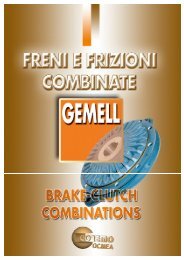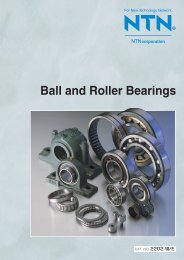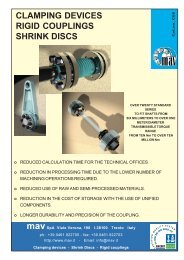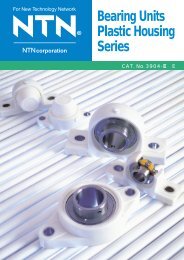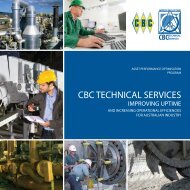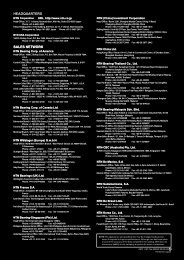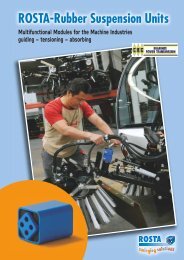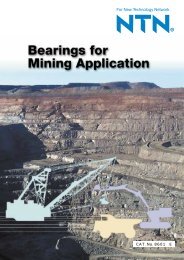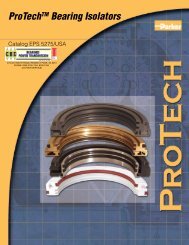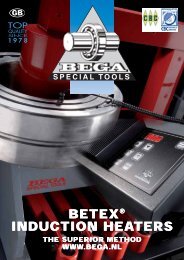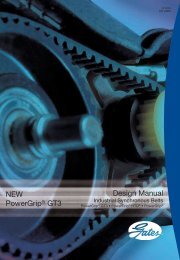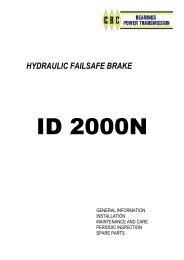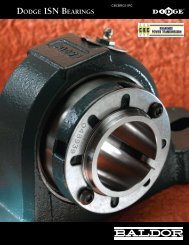Needle Roller Bearings - Ntn-snr.com
Needle Roller Bearings - Ntn-snr.com
Needle Roller Bearings - Ntn-snr.com
You also want an ePaper? Increase the reach of your titles
YUMPU automatically turns print PDFs into web optimized ePapers that Google loves.
Bearing Handling<br />
NTN<br />
Good example<br />
Fig.10.2 Press-fit<br />
Bad example<br />
(3) Shrinkage fit<br />
This shrinkage fit method is to fit the inner ring on a<br />
shaft after dipping it in hot oil for thermal expansion of<br />
its bore. This method is also widely used for<br />
installation of bearings. In heating the inner ring, lowcorrosive<br />
mineral oil or the like is used. In this case,<br />
the heated inner ring is natural-cooled down after<br />
shrinkage-fit, but simultaneously it shrinks in axial<br />
direction, too. Therefore, the inner ring must be<br />
pressed to the shaft shoulder until adequate cooldown,<br />
so as not to allow a clearance between the<br />
inner ring and the shoulder.<br />
In any case, however, it is not allowed to heat the<br />
inner ring up to over 120˚C.<br />
Fig. 10.3 shows the relationship of inner ring bore<br />
thermal expansion to heating temperature.<br />
Thermal expansion of inner ring bore m<br />
Required rising temperature = Heating temperature - room temperature<br />
280<br />
260<br />
240<br />
220<br />
200<br />
180<br />
160<br />
140<br />
120<br />
100<br />
80<br />
60<br />
40<br />
20<br />
Rising temperature 90˚C<br />
k5<br />
j5<br />
80˚C<br />
70˚C<br />
50 100 150 200 250 300 350 400 450 500 550 600<br />
Bearing bore diameter mm<br />
Fig. 10.3 Rising temperature required for shrinkage fit of inner ring<br />
60˚C<br />
r6<br />
p6<br />
n6<br />
m6<br />
50˚C<br />
40˚C<br />
30˚C<br />
280<br />
260<br />
240<br />
220<br />
200<br />
180<br />
160<br />
140<br />
120<br />
100<br />
80<br />
60<br />
40<br />
20<br />
10.3 Post-installation running test<br />
Bearing running test must be conducted on an installed<br />
bearing to check whether it was installed correctly. In this<br />
case, accelerating immediately the running speed up to<br />
the rated speed must be avoided absolutely. Doing so<br />
could result in damage of the bearing in the case of<br />
imperfect installation and seizure of the bearing in the<br />
case of inadequate lubrication. In testing, therefore, the<br />
shaft or the housing must first be rotated by hand and<br />
thereafter the shaft be rotated at low speed under no-load<br />
condition by the driving power, unless any failure is<br />
detected upon checking. After that, the running speed<br />
and load on the bearing must be accelerated and<br />
increased gradually while checking the running condition.<br />
Running sound level and tone of a bearing can be<br />
checked by a sound scope held in contact with the<br />
bearing housing. The sound is normal if it is a pure sound<br />
upon checking. In this case, high metallic sound or<br />
irregular sound from the bearing, if any, reveals<br />
occurrence of somewhat failure. In such a case, possible<br />
cause of the failure can be presumed by measuring<br />
quantitatively vibration amplitude and frequency using a<br />
vibrometer.<br />
Generally bearing temperature is presumed from the<br />
circumferential temperature of a housing. However, it can<br />
be judged more exactly if possible to measure directly the<br />
outer ring temperature by utilizing the oil hole thereof, etc.<br />
<strong>Needle</strong>ss to say, bearing temperature rises with elapse<br />
of the running time and reaches a constant level after a<br />
certain time. Rapid bearing temperature rise or continued<br />
temperature rise in excess to the constant level or<br />
abnormally high bearing temperature would reveals<br />
occurrence of somewhat failure. In such a case, careful<br />
check is required.<br />
Table 10.1 shows the required check items.<br />
Table 10.1<br />
Hand<br />
operation<br />
Power<br />
operation<br />
Variation in torque<br />
Over-torque<br />
Chattering<br />
Abnormal sound<br />
Abnormal noise<br />
and vibration<br />
Abnormal<br />
temperature<br />
<br />
Imperfect installation<br />
Under-clearance, great seal friction, etc.<br />
Indent and flaw on raceway surface<br />
Inclusion of dust and other foreign matter<br />
Inclusion of dust and other foreign matter,<br />
indent on raceway surface,over-clearance,<br />
inadequate lubrication<br />
Use of improper lubricant, imperfect<br />
installation, under-clearance<br />
10.4 Bearing removal (dismounting)<br />
Some related bearings are removed from each shaft,<br />
incurred by periodic disassembly or incidental trouble of a<br />
machine. In this case, these bearings must be handled<br />
with good care similarly to the case of installation, when<br />
they are reused or the condition thereof is examined after<br />
removed (dismounted). Too tight fit of a bearing would<br />
incur difficulty in dismounting and, therefore, the bearingrelated<br />
construction must be fully considered in design of<br />
A-50




